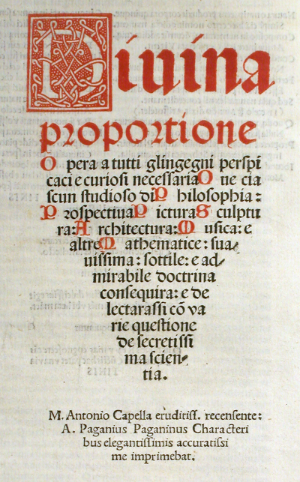
'divine proportion'

In 1498 Pacioli writes the book [i]Divina Proportione[/i]. [br]In 1509 a printed version is edited, with drawings by Leonardo da Vinci. Online you can read it in [url=https://archive.org/details/divinaproportion00paci]facsimile[/url].[br]In the first part, [i]Compendio divina proportione[/i] (Compendium about the divina proportion) Pacioli writes about the mathematical proportions and their applications in geometry, art and architecture.[br]Remarkable is that Pacioli doesn't write '[i]golden section[/i]' but '[i]divine proportion[/i]'.[br]Ever more remarkable are the reasons to use this term.[br][list=1][*]Its value stands for the [url=https://iep.utm.edu/divine-simplicity/]divine simplicity[/url].[br][/*][*]Its definitions points to 3 lengths, symbol for the Holy Trinity.[br][/*][*]Its irrationality stands for the incomprehensibility of God.[br][/*][*]The immutability: [i]As God is omnipresent and in avery part and whole, the proportion is always the same, regardless the absolute length of the separate parts involved.[/i][br][/*][*]Its relation with the dodecahedron points to the quintessece.[br][i]In philosophy the [url=https://what-and-how.net/what-is-quintessence]quintessence [/url]was the fifth, immaterial element. You can inscribe the other 4 Platonisc solids into an icosahedron, as God gives live to the other vier elements.[/i][/*][/list]The name is in fact a theological interpretation of some basic properties of [math]\varphi[/math] and no geometrical nor esthetical. Paccioli enumerates 13 'wonderful effect' of the GR, but these are 13 arithmical properties Euclides already mentioned in his Elements.[br]applets below illustrate some of them.